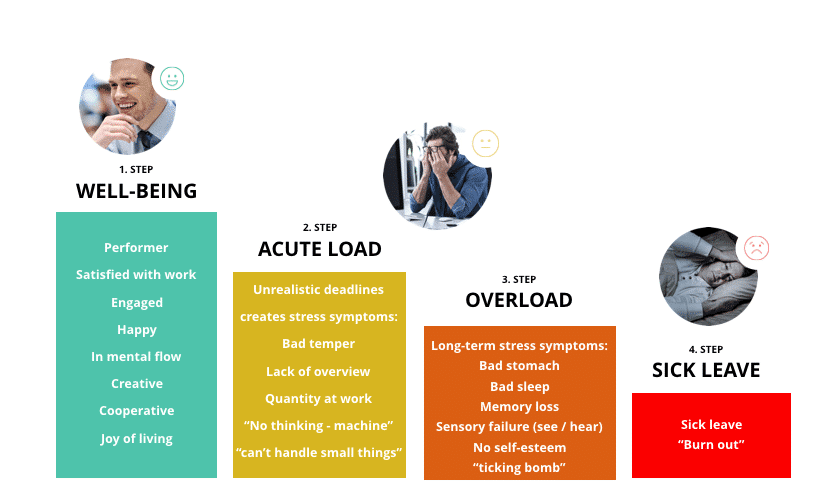Stress has gradually become a widely used term in many respects.
It is positive that there is a focus on this important problem. Absolutely.
But it’s a shame that stress has become such a used – and in many ways – diluted term.
Especially stress at the workplace is an incredibly important problem to deal with. In fact, you should ideally focus on preventing – and completely avoiding stress at work.
Because once the employee has been hit hard, it is difficult to get well again – and as you know, long-term sick leave costs an average of DKK 1,000,000 for the company.
Use the Stress Ladder

As you can see from the visualization here, you can use the stairs to place yourself and your employees in relation to stress level.
The ladder can give you a constant and continuous tool to know if there is something you need to pay extra attention to in relation to the stress level at your workplace.
It is also a really good idea to introduce the ‘Stress Ladder’ to all employees, so that everyone has a chance to register symptoms at the forefront – instead of being left with a sick note at the back.
We will all move back and forth on the Staircase – all depending on the work and personal situation. The most important thing here is that the situation on the 2nd and 3rd step is taken care of, so that the employee (or yourself) can move back again to step 1.
You cannot avoid experiencing stress symptoms in between. It’s perfectly okay and natural. The problem only arises when you have been in the condition for so long that your body and brain can no longer cope. And then it gets dangerous.
So use the stairs – and keep up to date with where your employees and yourself are at all times. Because of course – as a manager, you can also be pressured and called in sick!
Prevent stress at work – 10 good tips!
We all know it well.
If you need to avoid stress in the workplace, then the absolute best way is to focus on prevention.
When you get the situation taken care of in time, it will mean the world for both the employee in question, the working environment as a whole and not least the company.
You will therefore receive 10 steps to prevent stress in the workplace – directly to the work environment organisation’s well-being work.
1. Assessment!
You cannot prevent if you are not aware of what the current situation really is. What is the real starting point?
Here you use the Stress Ladder and start a dialogue about where you are gathered – and also whether anyone is in the specific danger areas.
Have a well-being measurement carried out with a view to the stress level and make sure to communicate to all employees why this measurement must be carried out and that the results will be taken seriously and dealt with to the highest degree.
2. Balance between requirements and resources
A dialogue with the management really needs to be started here. For now, it must be clarified which requirements are particularly stressful and which resources prevent stress.
You can also find out more about these answers by completing a well-being survey.
3. Prioritize
You can’t always achieve it all. No one can do that.
And it is important that everyone in the workplace becomes aware of which tasks must be prioritized and which can be saved for another day.
A clear prioritization of what is urgent and what is not urgent will invariably create a safe space for the individual employee – and not least relieve that person in relation to possible work pressure.
4. The meaning of it all
What is your core task? And does that make sense to you?
These are two rather important questions that all employees should be asked – and be able to answer.
We humans cannot sit for long with a core task that does not give us deeper meaning.
The individual employee must become wise about his ‘Why’ – and whether this opinion actually exists in the current core task. If it doesn’t, then something needs to be adjusted. And this cannot be done without the employee’s own insight and expectations for the future.
5. A definite stress policy
When you have become more aware of the stress level, have made a plan and know exactly how you as a company will work with the prevention of stress, a clear policy must be drawn up. No one should be in any doubt about how seriously stress is handled and how it is handled. The clearer and clearer it is to the employee, how seriously it is taken, the more secure the employee will be. And security equals well-being – and not least the calmness of saying it out loud, if you yourself feel that you are climbing the stress ladder at an inappropriate pace.
6. Stress rarely stands alone
When your employee is affected by stress, it is rarely the only factor that has pushed him/her over the edge.
Stress can be the result of many different challenges and problems within the working environment.
Again – become much wiser at an earlier time by completing a well-being measurement, heart rate measurement or the statutory APV.
These measurements give you the opportunity to feel moods, problems etc. at an early stage – and give you the opportunity to act on them. Before they end up in a state of stress.
7. Quick reactions are key!
If everyone in the company is introduced to the Stress Ladder, then you have already come a long way. Because it is an exceptionally good tool for placing colleagues and oneself in a possible danger zone.
But more than just familiarity is needed.
Because it is also important that you get a dialogue going that it is not only allowed, but a necessity to say it LOUD if a colleague or you yourself are in the danger zone.
It is not a taboo. Finally get that message across to everyone in the company.
And the faster you react – the easier it is to get the person back on the good step of the stairs.
8. Help each other
We are all employees and colleagues.
But first and foremost, we are human. And people need people.
Supporting each other both professionally and socially is an important resource for stress prevention. And the collegial support doesn’t just come out of nowhere. It requires the necessary framework to flourish and develop. Therefore, create the framework and get a good start in the dialogue about how to best support each other.
Again, we are all different and want to meet support in different ways. Through dialogue, we get to know each other better and gain insight into how we can best help the affected colleague, should the stress take over.
9. We hate change!
No matter how ready for change you say you are, it is always difficult to adapt to change – and especially if you already find yourself in a work environment that is time-pressed and fast-paced.
Both small and large changes can upset the balance in a working environment. Then you have to be at the forefront of any challenges, so think that into the change process. Make sure that all employees are sufficiently informed and take into account him/her who is not quite as happy with change as the rest.
10. Support – all over
The effective, preventive stress work is dependent on support all around the company. As an occupational health and safety representative, you cannot deal with the problem alone.
Make sure you get the management’s support in connection with the entire prevention work.
The dialogue with the higher levels of management is crucial for aligning expectations with the effort’s goals and means.
It is the employer’s full responsibility that the work is safe and healthy for the individual employee – please make this clear to the management in the same way.
(Source: Inspired by arbejdsmiljøweb.dk)
Prevent stress in the workplace – with IGLO
When we work daily with the working environment in many Danish companies, it is important to work based on some concrete, theoretical action measures. And the ones that we see time and time again work are the ones that stem from the IGLO model.
That is why we usually advise based on it.
Follow the IGLO model and strengthen your preventive efforts, and you will already be far in your well-being work.
You stand for Individual. G for Group. L stands for Management and O stands for Organization.
The whole idea with IGLO is that the well-being work takes place at all levels in the company – and that all those levels play together in relation to getting the concrete action plans executed and achieving increased well-being.
We start from the O and work our way up to the I…
Organizational level:
Create a good framework and a healthy working environment by creating a clear and concrete stress policy, so that all employees know that they can always safely approach and ask for help – without fear of reprisals.
Management level:
Introduce movement throughout the day (employees with pain are at higher risk of developing stress), joint stretching exercises and forced breaks.
Introduce Walk&Talks, where you look your employees in the eye and ask about their job satisfaction and general well-being.
Focus on the fact that you have a culture where people go home when the working day is over and should not feel pressured to work overtime.
Use the ‘Stress Staircase’ – as shown earlier. It is your tool for spotting your employees’ and also your own stress state.
Group level:
Start the dialogue – make it completely legal to talk about what stresses you out at work.
Create the necessary calm. If you are very disturbed during the working day, you cannot achieve your work tasks, and this will become a problem in the long term.
Keep a close eye on each other. Watch for signs and symptoms. Perhaps your colleague has started eating at his desk instead of in the canteen with everyone else. Or there is a clearly changed behavior.
Individual level:
If you feel unwell and experience clear symptoms of stress, report it as soon as possible to your immediate manager.
Openness and honesty are really the key words here, because the longer you hide it away and keep it to yourself, the faster you approach a stress level that is inappropriate – both for you and the company.
Predict and Prevent Workplace Stress with Woba
Woba’s mission is to create a better working world. We help companies streamline all employee surveys on the Woba platform, where employee feedback is turned into concrete actions that proactively address issues like resignations and sick leaves, including work-related stress.
With Woba, you can identify risks and early signs of work-related stress and take action before it’s too late.
Our customers experience significant improvements in the work environment and a reduction in absenteeism. The numbers below speak for themselves:
- 21% improvement in well-being and health
- 32% reduction in absenteeism
- 500% ROI in terms of lower absenteeism
Do you also want to enhance well-being and reduce absenteeism in your company?









